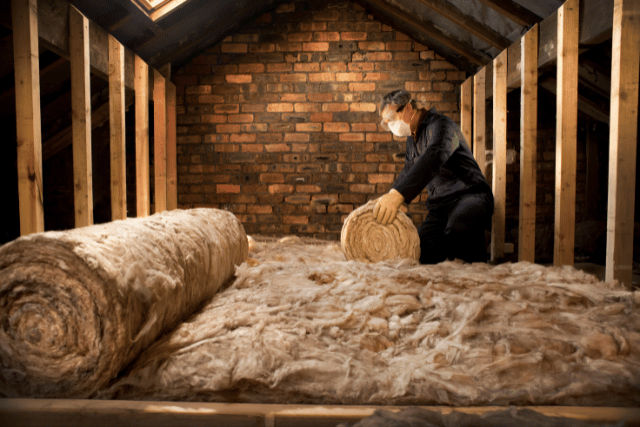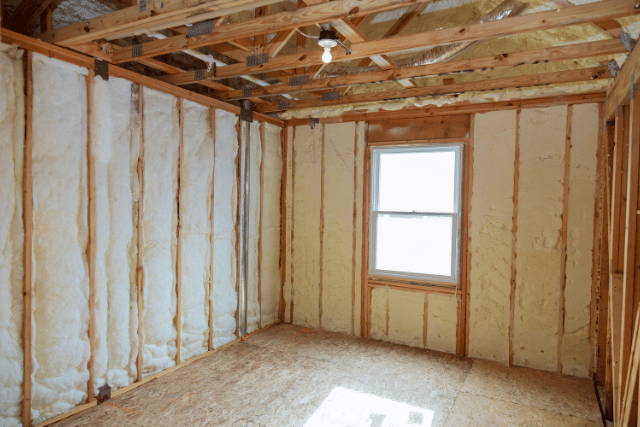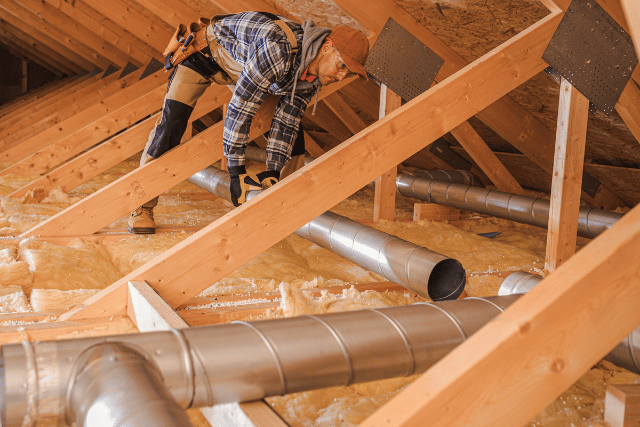What Is Loft Insulation? How Does Loft Insulation Work?
Loft insulation refers to the practice of adding insulation material to the space beneath the roof in a building, commonly known as the loft or attic.
How does loft insulation reduce heat loss? The primary purpose of loft insulation is to create a thermal barrier that prevents heat from escaping through the roof, thus improving the energy efficiency of the building.
This process helps to keep the interior of the building warmer in cold weather and cooler in hot weather, making the indoor environment more comfortable and reducing the need for excessive heating or cooling.
Loft insulation is a key component of a building’s overall insulation system. It is especially important because warm air naturally rises, and without proper insulation, a significant amount of heat can be lost through the roof.
By insulating the loft, you create a buffer that slows down the transfer of heat between the inside of the building and the outside environment.

Insulation Materials
What is the best loft insulation? Insulation materials used for loft insulation include:
Blanket Insulation – This is the most common type of loft insulation and typically comes in rolls or batts. It is often made from materials like fiberglass, mineral wool (rock wool), or natural fibres like sheep’s wool. Blanket insulation is easy to handle and can be laid between the joists and rafters in the loft space.
Loose-Fill Insulation – Loose-fill insulation consists of small particles or fibres that are blown or poured into the loft space. Materials such as cellulose, fiberglass, or mineral wool are commonly used for loose-fill insulation. This type of insulation is particularly useful for irregularly shaped spaces or areas with obstacles.
Spray Foam Insulation – Spray foam insulation involves spraying a liquid foam material that expands and solidifies, filling gaps and creating an effective insulation layer. It is ideal for sealing hard-to-reach spaces and providing an airtight barrier.
Step-by-step Guide to Loft Insulation
Ever wondered how to lay loft insulation? Here is our step by step guide on how to insulate a loft:
- Before you start, check your loft’s existing insulation and assess its condition. If there’s already insulation present but it’s insufficient, you can add more on top.
- Purchase the appropriate insulation material based on your loft’s needs. Make sure to measure the area accurately to ensure you buy enough insulation.
- Wear appropriate protective gear, including gloves, a mask, and eye protection, when handling insulation materials.
- If your loft is used for storage, temporarily remove items to create a clear workspace. Make sure to move carefully to avoid stepping on the ceiling below.
- Before laying insulation, seal any gaps, cracks, or holes in the loft floor and around pipes, wires, and vents. This prevents air leakage, maximizing the insulation’s effectiveness.
- For blanket insulation, roll it out between the joists, ensuring a snug fit. Be careful not to compress the insulation, as this reduces its effectiveness. If using loose-fill insulation, distribute it evenly to the recommended depth.
- While insulation is important, so is proper ventilation. Don’t cover any soffit vents or block air circulation paths, as this could lead to moisture buildup and potential issues.
- If your loft has an access hatch, consider upgrading it to an insulated and airtight version to prevent heat from escaping.
Insulating your loft is a practical and cost-effective way to make your home more energy-efficient and comfortable. By following this guide, you can take the necessary steps to install loft insulation properly.
The benefits of reduced energy bills, improved comfort, and a smaller carbon footprint make loft insulation a home improvement project that’s well worth the effort and investment.

How To Cut Loft Insulation
Cutting loft insulation is a common task when installing or adding insulation to your loft or attic space. Properly cutting insulation allows you to fit it neatly between joists, rafters, or other structural elements.
You will need:
- Loft insulation materials
- Measuring Tape
- Straight Edge (long ruler or board)
- Utility knife or insulation knife
- Safety gear (gloves, mask and eye protection)
- Measure the distance between the joists or rafters where you will be putting the insulation – be sure to measure both length and width.
- Unroll the insulation and lay it on a clean flat surface.
- Mark the insulation using a straight edge ruler, draw light lines or make small marks on the insulation surface.
- Put on your safety gear before cutting the insulation. Use the knife to cut along the marked lines.
Is Loft Insulation dangerous or flammable?
Loft insulation materials that are properly installed and meet safety standards are generally not dangerous or highly flammable. However, it’s important to choose the right type of insulation material and follow safety guidelines during installation to ensure that the insulation does not pose a risk. Here are some key points to consider:
Most common loft insulation materials, such as mineral wool (glass or rock wool) and fiberglass, are classified as non-combustible or have high fire resistance. They do not readily catch fire and can help slow the spread of flames. However, while these materials themselves are not highly flammable, they can melt or smoulder if exposed to extremely high temperatures.
During installation, it’s important to avoid covering electrical components, wiring, and light fixtures with insulation. This helps prevent overheating and potential fire risks. Any electrical work should be done by a qualified electrician.
When choosing insulation materials, look for products that have been tested and certified by relevant safety and building standards organisations. These certifications indicate that the insulation meets safety and performance criteria.
Adequate ventilation is essential to prevent moisture buildup in the loft space, as excess moisture can lead to mould growth and potentially impact the effectiveness of the insulation. Proper ventilation helps maintain a healthy and safe environment.
In some older homes, particularly those built before the 1980s, there might be asbestos-containing insulation materials. Asbestos is a hazardous material and should be handled by professionals trained in asbestos removal.
In summary, loft insulation itself is not typically dangerous or highly flammable when installed correctly and with appropriate safety measures. It’s important to choose insulation materials that meet safety standards, follow installation guidelines, and take precautions to prevent fire risks and ensure proper ventilation.

Who Is Eligible For A Loft Insulation Grant?
Can I get free loft insulation? To qualify for a loft insulation grant, you or someone in your household must be receiving one of the following benefits:
ECO4 eligible benefits:
- Income Based Jobseekers Allowance (JSA)
- Income Related Employment & Support Allowance (ESA)
- Income Support (IS)
- Pension Credit Guarantee Credit
- Working Tax Credit (WTC)
- Child Tax Credits (CTC)
- Universal Credit (UC)
- Housing Benefit
- Pension Credit Savings Credit
Apply For A Loft Insulation Grant
Apply for a loft insulation grant today by filling out our quick eligibility form below. Once you have filled out the form, a member of our team will be in touch with you to discuss the next steps.
Loft Insulation Frequently Asked Questions
This depends on the size of your loft space and if you are having new insulation installed or refreshing old insulation.
Current building regulations recommend loft insulation should be 300mm deep (mineral or glass wool).
Depending on the type of loft insulation you may be looking for – £25 per m² loft insulation top up plus £400 day labour and £40 per m² for loft insulation full relay plus £400 day labour.
Yes – you may be eligible for loft insulation if your household income is less than £31,000 gross.
If your loft is easy to access and does not have any damp issues – it is possible to insulate it yourself. However, if there are cases of the loft being damp or a more complex insulation system is needed, always leave it to the professionals.

